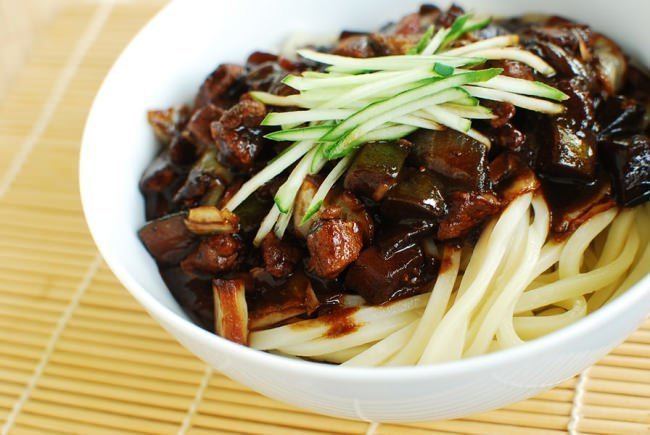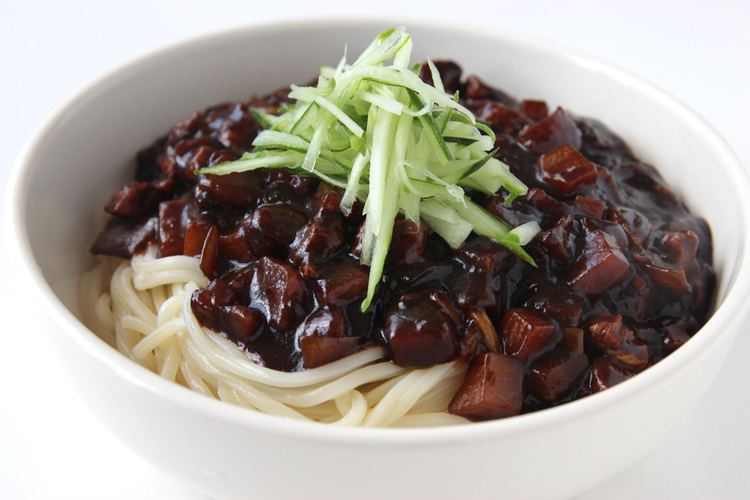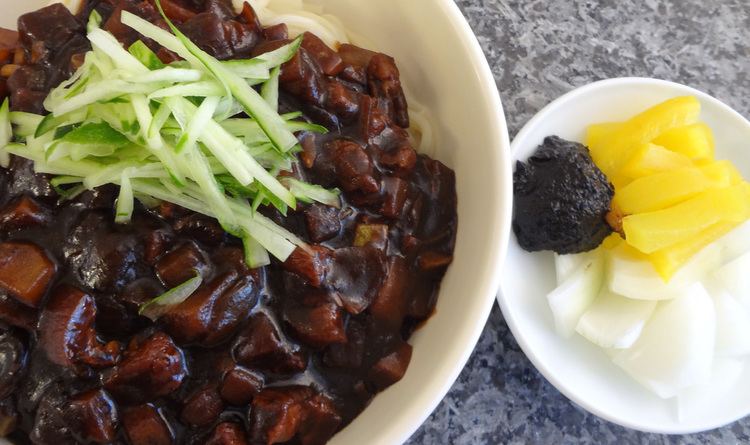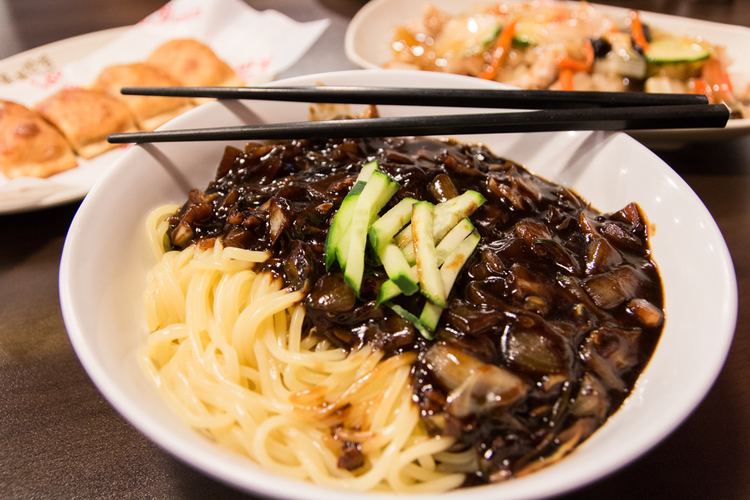Alternative names Jjajangmyeon Place of origin Korea | Type Myeon Similar dishes Zhajiangmian | |
 | ||
Similar Jjamppong, Sweet and sour pork, Tteok‑bokki, Mandu, Gimbap | ||
Noodles in black bean sauce jjajangmyeon jajangmyeon recipe season 4 ep 3
Jajangmyeon (자장면) or jjajangmyeon (짜장면) is a Korean Chinese noodle dish topped with a thick sauce made of chunjang (춘장; black bean sauce), diced pork and vegetables, and sometimes also seafood.
Contents
- Noodles in black bean sauce jjajangmyeon jajangmyeon recipe season 4 ep 3
- Noodles with blackbean sauce jjajangmyeon
- History
- Etymology
- Noodles
- Sauce
- Accompaniments
- Variations
- References
Noodles with blackbean sauce jjajangmyeon
History

In 1905, the first jajangmyeon was first made in Gonghwachun (공화춘; 共和春), a restaurant in Incheon Chinatown ran by a Chinese immigrant from Shandong Province of China. The restaurant is now the Jjajangmyeon Museum.
Although the name of jajangmyeon is cognate with the Chinese dish called zhájiàngmiàn (炸酱面), Korean jajangmyeon differs from Chinese zhájiàngmiàn in many ways. Yong Chen, an associate history professor at the UCI, says "Though this dish began as the Northern Chinese noodle-and-ground pork dish zhájiàngmiàn, it is thoroughly Korean."
Etymology
Jajang (자장; alternately spelled jjajang 짜장) derived from the Chinese word zhájiàng (炸酱), which means "fried sauce". Myeon (면) means "noodles". The Chinese characters are pronounced jak (작; 炸) and jang (장; 醬) in Korean, but the noodle dish is called jajangmyeon, not jakjangmyeon, because its origin is not the Sino-Korean word, but the transliteration of the Chinese pronunciation. As the Chinese pronunciation of zhá sounded like jja (rather than ja) to Korean ears, the dish has been known in South Korea as jjajangmyeon, and the vast majority of Korean Chinese restaurants use this spelling. However, the National Institute of Korean Language did not recognize the spelling as a solidified idiomatic transliteration until 22 August 2011, when it accepted jjajangmyeon as an alternate standard spelling of the dish alongside the existing jajangmyeon. The non-inclusion of jjajangmyeon as the standard spelling was based on the rules for foreign words transliteration announced in 1986 by the Ministry of Education, which stated that the foreign obstruents should not be transliterated using doubled consonants except for some established usages. Consequently, there were noticeable criticism on the standard transliteration. Those in favor of the jjajangmyeon questioned if jjamppong should really be called jambong as per the official manual. In the 95th episode of Korean food culture cartoon Sikgaek, Ahn Do-hyeon, the Sowol Poetry Prize winning Korean poet, announced that he would always write the dish's name as jjajangmyeon, not jajangmyeon, because the former is the name with which he associates all his childhood memories of the dish. Both spellings are included in the Standard Korean Language Dictionary since 31 August 2011.
Noodles

Jajangmyeon uses thick noodles made from white wheat flour. The noodles, which are made entirely by hand and not by machines, are called sutamyeon (수타면; 手打麵) are praised in South Korea as an essential ingredient of good jajangmyeon.
Sauce

In China, yellow soybean paste (黃醬) is used, in Tianjin and other parts of China tianmianjiang (甜麵醬), hoisin sauce (海鮮醬), or broad (fava) bean sauce (荳瓣醬) may be used in place of the yellow soybean paste. However, In Korea, the sauce is made with a dark soybean paste. This paste, which is made from roasted soybeans and caramel, is called chunjang (literally "spring paste", hangul: 춘장; Chinese: 春醬) when unheated, while the heated sauce (containing vegetables and meat or seafood) is called jjajang (literally "fried sauce"). Chunjang is stir-fried with diced onions, ground meat (either beef or pork) or chopped seafood, and other ingredients. The meat stock is added to reduce the salty taste, and potato starch or cornstarch is added to give the sauce a thick consistency. The sauce is served hot over noodles, sometimes with sliced raw cucumbers. The same sauce is also used to make jajangbap (rice served with the sauce) and jajangtteokbokki (tteokbokki made with the sauce instead of the usual spicy sauce).
Accompaniments
Jajangmyeon is usually served with a small amount of danmuji (단무지). Danmuji are made of radish. The dish is often served with a small amount of sliced raw onions, seasoned with rice vinegar, accompanied with a little chunjang sauce. The diner eats the noodle with danmuji and onions dipped in chunjang sauce.
Variations
Variations of the jajangmyeon dish include ganjajangmyeon (간자장면), which is jajangmyeon served with the jajang sauce without the starch, with the sauce and noodles being served separately in different bowls, and samseon jajangmyeon (삼선자장면; 三鮮炸醬麵), which incorporates seafood such as squid, shrimp, sea cucumber, and others (but never fish). Samseon ganjajangmyeon (삼선간자장면; 三鮮간炸醬麵) consists of noodles served with sauce, which contains seafood on the side. Jajangbap is essentially the same dish as jajangmyeon, but made with rice instead of noodles.
Instant jajangmyeon consists of dried noodles that are boiled in the same manner as instant ramen with dried vegetable bits, drained, and mixed with jajang powder and a small amount of water and oil.
